Roti Recipe- How to make Roti/Chapati
Roti or Chapati is everyday Indian flatbread which is made with only 2 ingredients- whole wheat flour (atta) and water. Learn all the tips to make soft roti at home!
This post may contain affiliate links. Please read our disclosure policy.
Learn all the tips and tricks to make soft roti at home.
This everyday Indian flatbread was a staple growing up, one that I ate every single day.
Roti is made of whole wheat flour and nothing else really and is eaten in India with dal and curries.
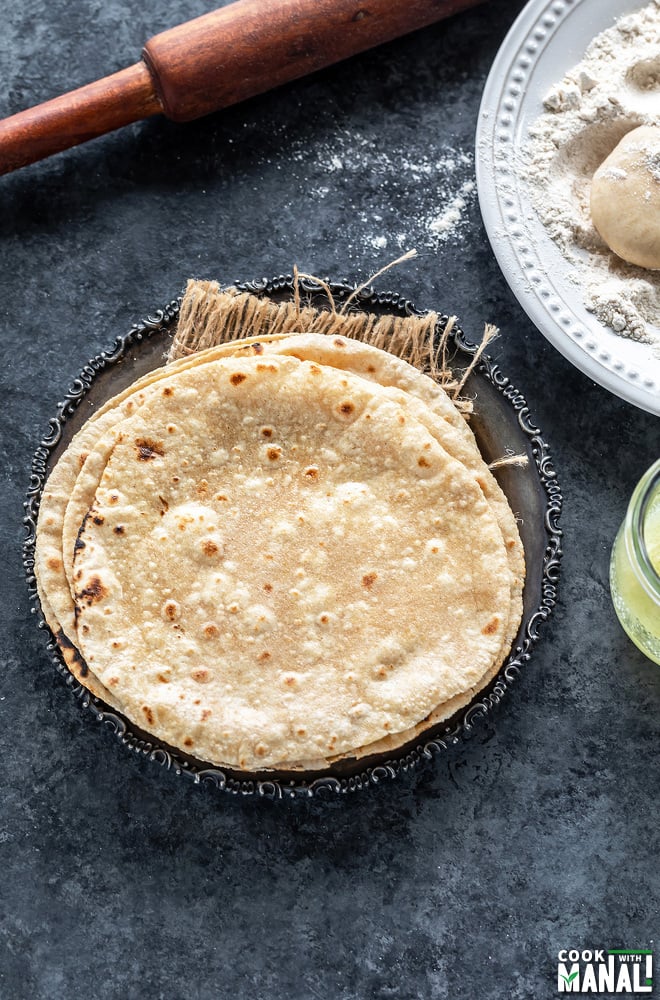
Roti is an integral part of Indian cuisine, the north Indian cuisine especially.
I was born and raised in north India and grew up eating it everyday of my life.
Roti, dal and rice were always on the table in my house for literally every meal.
It took me several years to learn to how to make a good roti. Trust me, it’s a skill which needs a lot of practice.
I learnt so much cooking but this was something that took time. Now, after making years I am confident enough to make rotis and make them several times every week.
What is Roti?
In simple words, roti is a flatbread made with wholemeal wheat flour. It is known as “atta” in hindi.
Atta is also used to make other breads like paratha and puris in India on a daily basis.
Roti is simplest bread that is made everyday in Indian households. It is made with only 2 ingredients- atta (the wheat flour) and water.
Some people add salt, some add oil but in my house it was always made with these 2 ingredients only.
Like I said, it is the simplest form of bread.
It is known by different names in different parts of the country and sometimes there’s also a difference in the way you cook it.
Roti/Phulka/Chapati/Rotli are more or less the same thing.
They might have some difference in their thickness (like rotli in Gujarat is very thin while my North-Indian version is slightly thicker) and the way they are cooked but more or less they are same.
You need a rolling pin and a rolling board to make this flatbread. We call it chakla (the board) and belan (the rolling pin) in hindi.
Is roti vegan? Yes, if you don’t apply ghee on the roti after it’s cooked, then it is vegan.
My mom never applied any ghee on roti, I guess it’s just not a tradition to have ghee on roti in eastern Uttar Pradesh (where I am from).
On the other hand, Sarvesh never ate roti without ghee! He’s a punjabi and ghee is must on rotis for him.
If you want to keep it vegan, simply skip the ghee or use vegan butter.
Is roti gluten-free? The traditional roti is not gluten-free since it is made of wheat.
How is Roti Cooked
So this will vary in different parts of the country.
At my home, it was first rolled and cooked on tawa until cooked slightly and then put on direct flame until it puffs.
But at a lot of people I know (including my mother-in-law), cook it all on the tawa.
She simply uses a cloth to puff the roti directly on the tawa. Both ways are fine, it’s just what you are used to.
I usually puff it directly on flame since I like the taste better that way or maybe it’s because my tastes buds are just more used to that taste of the bread cooked on direct flame.
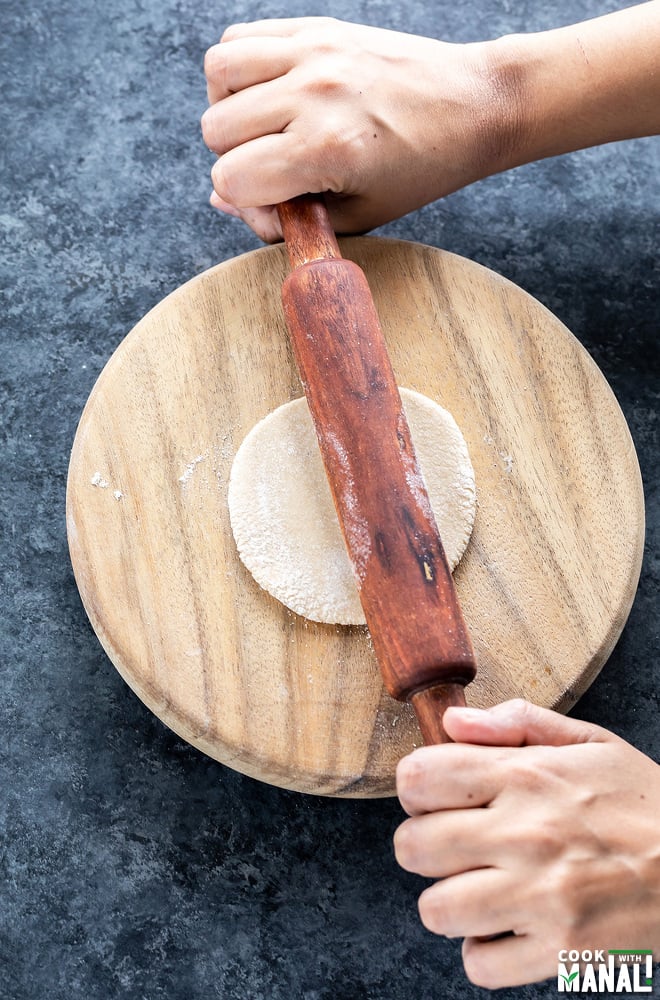
Tips to make soft rotis
One of the biggest challenges that I faced when I first started making rotis was that they never turned out soft.
Sometimes, they would be so hard that they could crack like a wafer. Not kidding!
Over the years and hundred of roti later, I can now make good rotis. I tried everything from adding milk to yogurt and what not but eventually realized that you don’t need any of these.
It’s a skill which comes with practice. The more you make it, the better you will get. Each step right from making the dough, kneading it, to rolling the roti is important and has an effect on the final outcome.
I am sharing you some of the things that I have learned in my roti making journey! 🙂
The dough needs to be soft and pliable– now, I know this can get confusing. But you have to knead a soft dough.
If the dough feels too tight- add more water, start by adding 1-2 teaspoons at a time and add more as needed.
If the dough feels too wet/sticky- add more flour.
It should be smooth and when you press the dough with your fingers, it should leave an impression.
Knead with warm water- not a really big deal but it definitely helps if you use warm water to knead the dough.
You can even add some oil to the dough. I don’t do it though but some swear by it.
Knead the dough with the knuckles on your fingers- stretch the dough, knead using the knuckles, then fold and knead again.
Keep doing this until your dough is smooth and pliable.
Let the dough rest for 20 to 30 minutes- now this is really important. After you knead the dough, cover it with a damp cloth or a damp paper towel and let it rest for 20 to 30 minutes.
The makes the rolling easier, the rotis so much better.
Roll each dough ball to a smooth ball, round and no cracks- to roll a good roti, start with making sure that dough that you are going to roll is round and smooth.
If you start with a nice round and smooth dough, your chances of making a good roti will increase. Once the ball is round, then press it lightly between your palms to make it little flat.
Roll evenly using a rolling pin– ah! the toughest thing to do and this definitely comes with practice.
You have to apply equal pressure while rolling the roti and once you master it, the roti will automatically move as you roll.
Move the rolling pin all the way through the rolled roti so that it rolls evenly from all sides. Comes with practice so definitely don’t worry if you can’t do it in the first go.
Tawa should be hot before you add the rolled roti– this is one mistake that I did when I started making rotis and paratha. My tawa wouldn’t be hot enough and I would add the rolled roti to it.
The roti will take more time to cook since the tawa was not hot and that would result in a hard over-cooked roti.
So, make sure sure the tawa is heated well on medium-high heat before you put the roti on it.
Dust the dry flour (atta) from the rolled roti before putting it on the hot tawa– it makes your roti less dry and more soft.
Apply ghee once done- to add to the flavor and also to keep them soft, brush them with ghee once cooked.
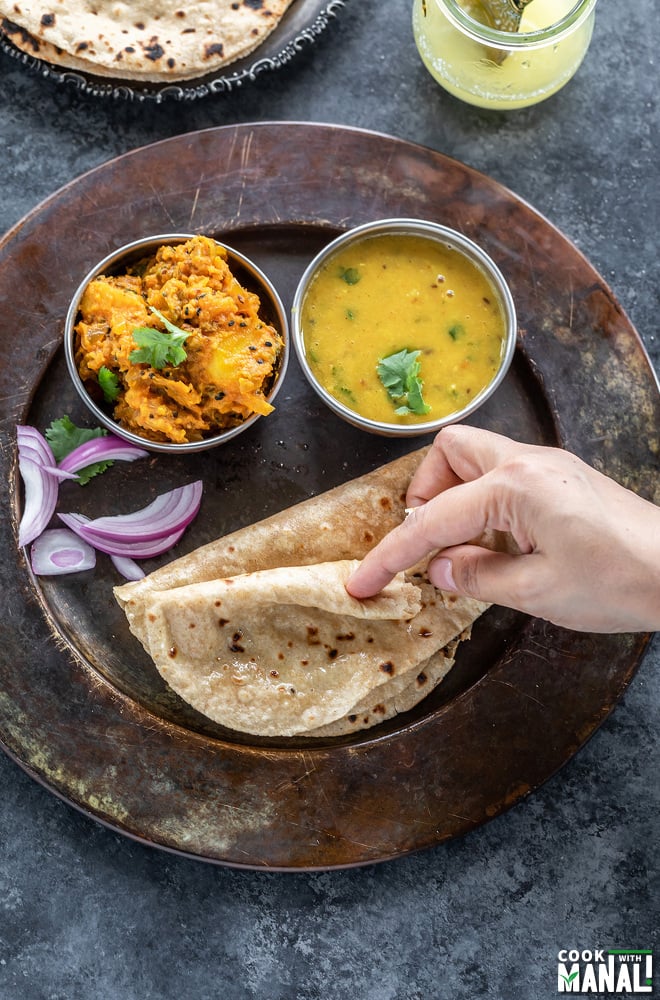
Why my roti didn’t puff?
The most frustrating part of this entire roti making process happens when it doesn’t puff.
Even after making it for many years, I still have rotis which won’t puff.
The biggest reason is that it wasn’t rolled evenly. If it’s rolled too thin, to the point where edges are almost tearing apart (and the center of the roti is thick), then the roti won’t puff.
Make sure that its thickness is same throughout, that’s a good roti which will puff.
It also won’t puff if the dough was too tight/hard.
Frequently Asked Questions
How to store roti? If I am sending them with my husband to work, I always put an aluminium foil first, then a paper towel and then place the roti on top.
If you just roll them in an aluminium foil or paper towel, they will become soggy.
I store them the same way in the refrigerator with two layers.
How to re-heat roti? You can microwave them, just cover them with a damp cloth and microwave for 30 seconds.
You can sprinkle some water on the roti before heating them up.
Can you freeze these? Yes, you can freeze them. Just let it come down to room temperature.
Then place a parchment paper between each roti and make a stack. Then transfer the entire stack into a freezer bag and freeze.
Which brand of atta is the best? I use Sujata Gold atta and find it the best for rotis. You can use the brand that you like.
Method
1- Take 2 cups (270 grams) atta in a large bowl. Usually a round flat plate with shallow edges called paraat is used but I just had a round mixing bowl so that’s what I used.
You can add little oil if you like here, I did not add any.
2- Start adding water, little by little.
3- As you add water, mix with your hands and bring the dough together. I needed around 3/4 cup (180 ml) +1 tablespoon (15 ml) water here. You may need more or less water depending on the kind of flour.
4- Once the dough comes together, start kneading the dough. Knead with the knuckles of your finger, applying pressure.
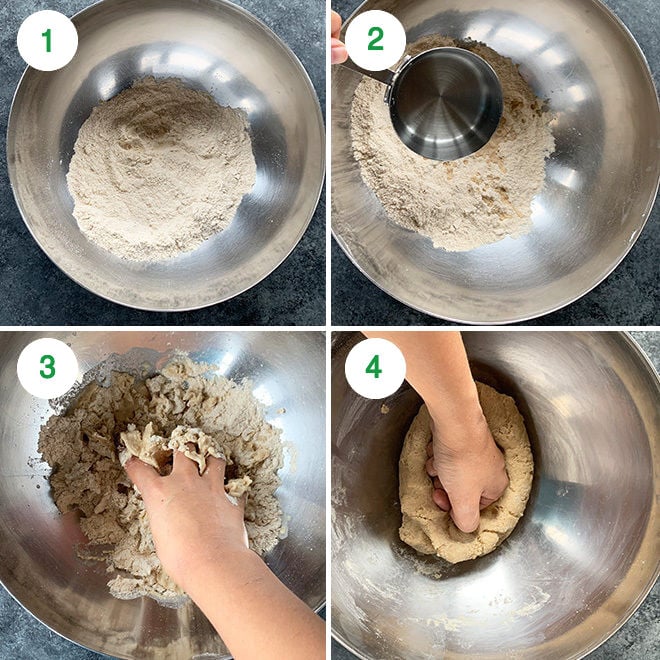
5- Fold the dough using your palms and knead again applying pressure with your knuckles.
6- Keep kneading until the dough feels soft and pliable. If it feels hard/tight, add little water and knead again. If it feels too sticky/soft, add some dry flour and mix.
7- Once done, the dough should be smooth. Press the dough with your fingers, it should leave an impression.
8- Cover the dough with a damp cloth or paper towel for 20 to 30 minutes.
I placed my paper towel under tap water and then squeezed all the water from it and used that damp paper towel to cover the cloth.
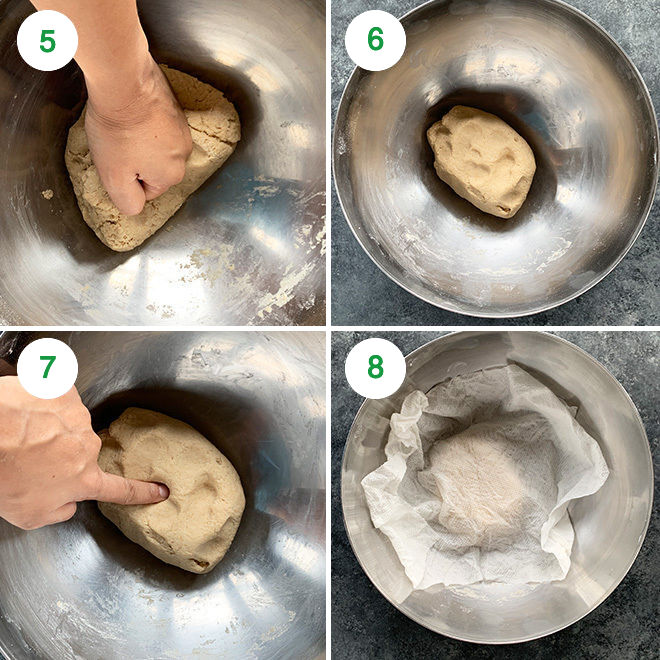
9- After the dough has rested, give it a quick knead again.
10- Divide the dough into 12 equal parts, each weighing around 35 to 37 grams.
11- Start working with one ball, while keep the remaining dough balls covered with a damp cloth so that they don’t dry out. Take one of the balls and press it between your fingers to make it smooth.
Then roll it between your palms to make it round and smooth. There should be no cracks.
12- Press the round dough ball and flatten it slightly.
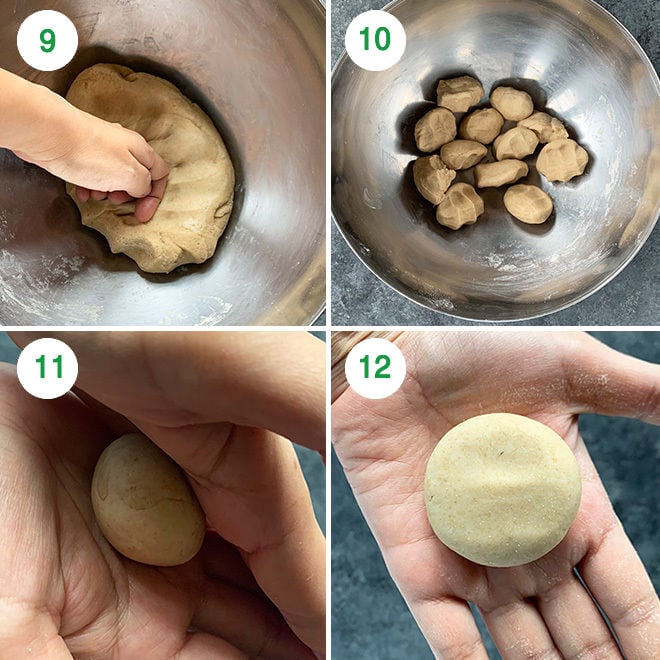
13- Now take around 1/4 cup atta in a plate for dusting the roti while rolling it. Dip the prepared dough ball into the dry flour and dust it from all sides.
14- Then start rolling the roti, using a rolling board and rolling pin.
15- Move the rolling pin lengthwise across the dough applying gentle pressure as you roll. If you are rolling it correctly, the dough will move in circular motion on its own and the roti will roll evenly. This comes with practice.
You can also roll and then take the dough and move it a little with your hands and roll again.
You will have to dip the roti in dry flour several time while rolling the roti. Anytime the dough starts sticking to the rolling pin, dip the roti into the atta from both sides and then continue rolling.
16- Roll it thin until you have a 5 to 6 inch diameter circular roti.
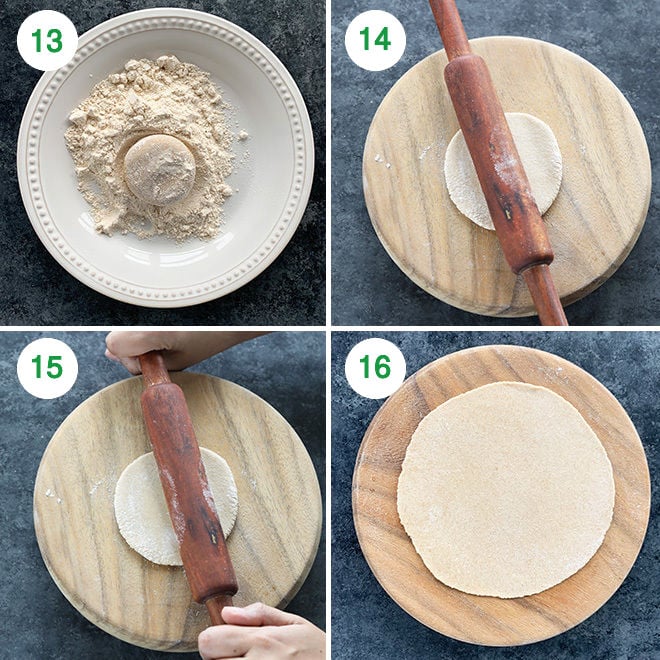
17- Heat the tawa (skillet) on medium-high heat. Make sure the tawa is hot enough before you place the roti on the tawa.
Dust excess flour off the rolled roti and place it on the hot tawa.
18- Let it cook for 15-30 seconds until you see some bubbles on top side. At this point flip the roti, you don’t want the first side to cook too much.
19- Now, let the other side cook more than the first side around 30 seconds more. Use a tong to see how much it has cooked from the second side now. If you see brown spots all over, means it has cooked enough.
20- Now, remove the roti from the tawa using a tong and place it directly on flame with the first side (which was little less cooked) directly on the flame.
The roti if rolled evenly will puff up, flip with a tong to cook the other side as well. The roti is done when it has brown spots, don’t burn it.
Apply ghee on the rotis immediately. Make all the roti/phulka similarly.
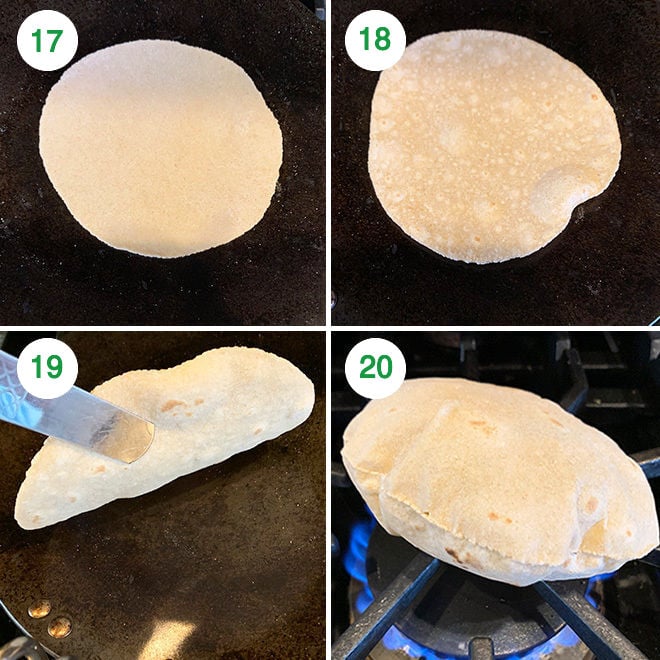
What if you have an induction top and can’t puff the roti on flame.
No worries, here’s how you can make chapati (or roti whatever you call it) on tawa without putting it directly on flame to puff.
21- Roll the roti as usual and place it on the hot tawa.
22- Let it cook for 30 seconds until you see some bubbles on top. At this point flip the roti. You don’t want the first side to cook a lot.
23- Now, let the other cook side until it has nice brown spots (so it should cook more than the first side).
24- Now flip again (with the first side now at the bottom), press the roti with a paper cloth, any cotton cloth or spatula. It will puff up.
Flip again to cook the other side some more. Remove from tawa and brush with ghee.
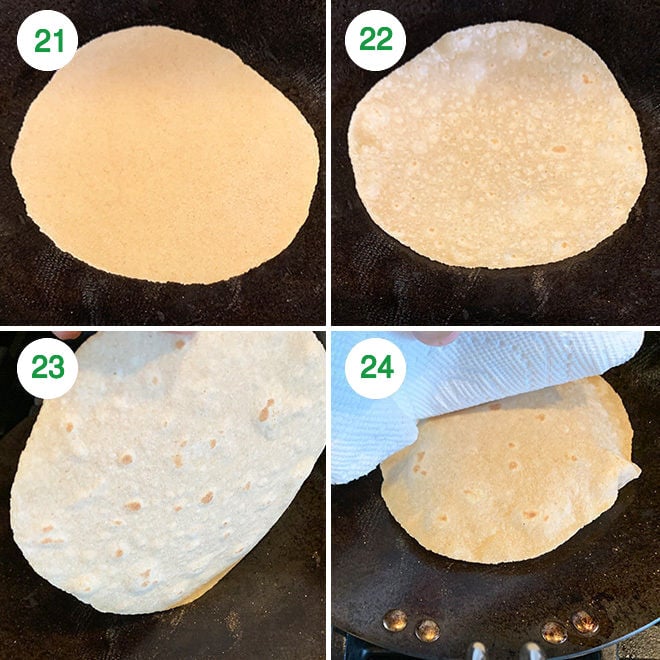
The rotis are best enjoyed warm! Serve then with dal like dal tadka and simple Indian stir-fry like bhindi masala or aloo palak.
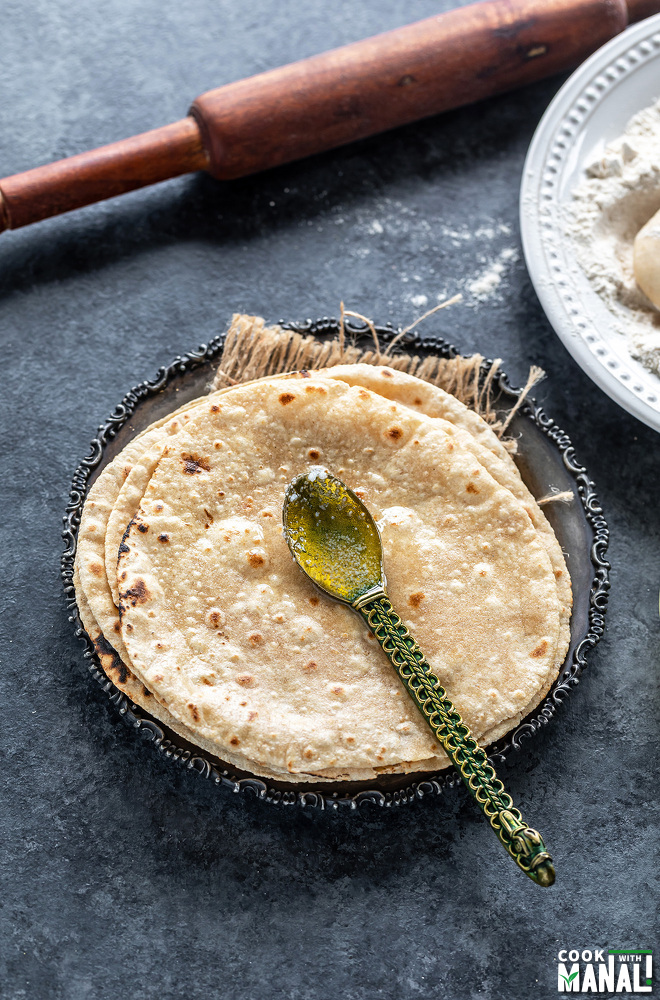
If you’ve tried this Roti Recipe then don’t forget to rate the recipe! You can also follow me on Facebook and Instagram to see what’s latest in my kitchen!
Roti Recipe - How to Make Roti/Chapati
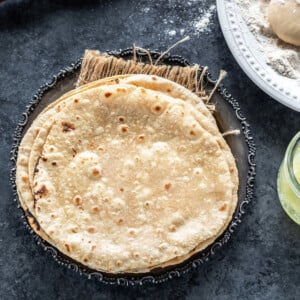
Ingredients
- 2 cups atta whole wheat flour, 270 grams + 1/4 cup for rolling the roti
- 1-2 teaspoons oil optional, 5-10 ml
- water as needed to knead a soft dough, I used around 3/4 cup (180 ml) + 1 tablespoon (15 ml)
- ghee to brush the rotis
Instructions
Knead the dough
- Take 2 cups (270 grams) atta in a large bowl. Usually a round flat plate with shallow edges called paraat is used but I just had a round mixing bowl so that's what I used.You can add little oil if you like here, I did not add any.
- Start adding water, little by little. As you add water, mix with your hands and bring the dough together. I needed around 3/4 cup (180 ml) +1 tablespoon (15 ml) water here. You may need more or less water depending on the kind of flour.
- Once the dough comes together, start kneading the dough. Knead with the knuckles of your finger, applying pressure.
- Fold the dough using your palms and knead again applying pressure with your knuckles.Keep kneading until the dough feels soft and pliable. If it feels hard/tight, add little water and knead again. If it feels too sticky/soft, add some dry flour and mix.
- Once done, the dough should be smooth. Press the dough with your fingers, it should leave an impression.
- Cover the dough with a damp cloth or paper towel for 20 to 30 minutes.I placed my paper towel under tap water and then squeezed all the water from it and used that damp paper towel to cover the cloth.
Roll the roti
- After the dough has rested, give it a quick knead again.Divide the dough into 12 equal parts, each weighing around 35 to 37 grams.
- Start working with one ball, while keep the remaining dough balls covered with a damp cloth so that they don't dry out.
- Take one of the balls and press it between your fingers to make it smooth. Then roll it between your palms to make it round and smooth. There should be no cracks. Press the round dough ball and flatten it slightly.
- Now take around 1/4 cup atta in a plate for dusting the roti while rolling it. Dip the prepared dough ball into the dry flour and dust it from all sides.
- Then start rolling the roti, using a rolling board and rolling pin.Move the rolling pin lengthwise across the dough applying gentle pressure as you roll. If you are rolling it correctly, the dough will move in circular motion on its own and the roti will roll evenly. This comes with practice.
- You can also roll a little and then take the roti and move it a little with your hands and roll again. Roll it thin until you have a 5 to 6 inch diameter circular roti.You will have to dip the roti in dry flour several time while rolling the roti. Anytime the dough starts sticking to the rolling pin, dip the roti into the atta from both sides and then continue rolling.
Cook the roti
- Heat the tawa (skillet) on medium-high heat. Make sure the tawa is hot enough before you place the roti on the tawa.Dust excess flour off the rolled roti and place it on the hot tawa.
- Let it cook for 15-30 seconds until you see some bubbles on top side. At this point flip the roti, you don't want the first side to cook too much.Now, let the other side cook more than the first side, around 30 seconds more. Use a tong to see how much it has cooked from the second side now. If you see brown spots all over, means it has cooked enough.
- Now, remove the roti from the tawa using a tong and place it directly on flame with the first side (which was little less cooked) directly on the flame.The roti if rolled evenly will puff up, flip with a tong to cook the other side as well. The roti is done when it has brown spots, don't burn it.
- Apply ghee on the rotis immediately. Make all the roti/phulka similarly. Serve warm.
Making Roti/Chapati on Induction top (without puffing on flame)
- here's how you can make chapati (or roti whatever you call it) on tawa without putting it directly on flame to puff.Roll the roti as usual and place it on the hot tawa. Let it cook for 30 seconds until you see some bubbles on top. At this point flip the roti. You don't want the first side to cook a lot.
- Now, let the other side cook until it has nice brown spots (so it should cook more than the first side). Now flip again (with the first side now at the bottom), press the roti with a paper cloth, any cotton cloth or spatula. It will puff up.
Flip again to cook the other side some more. Remove from tawa and brush with ghee.
Notes
Nutrition
Nutrition information is automatically calculated, so should only be used as an approximation.

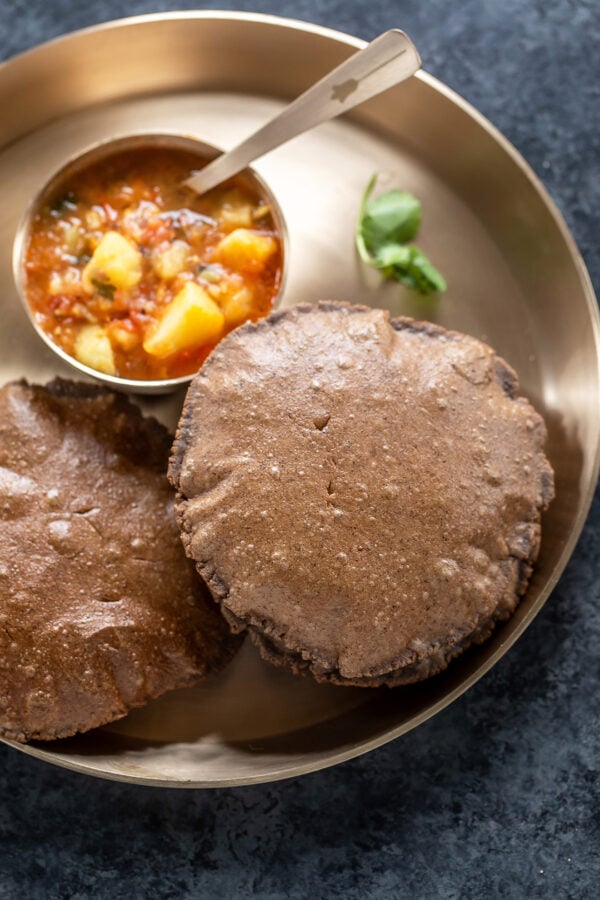
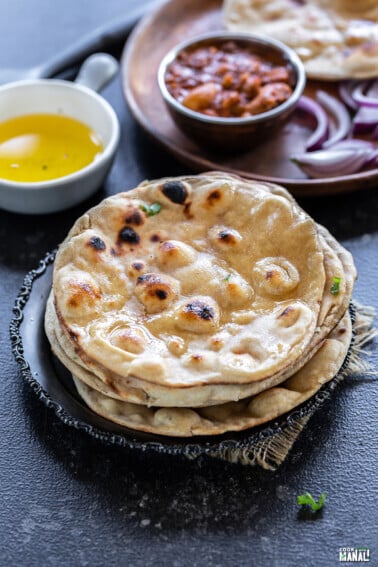
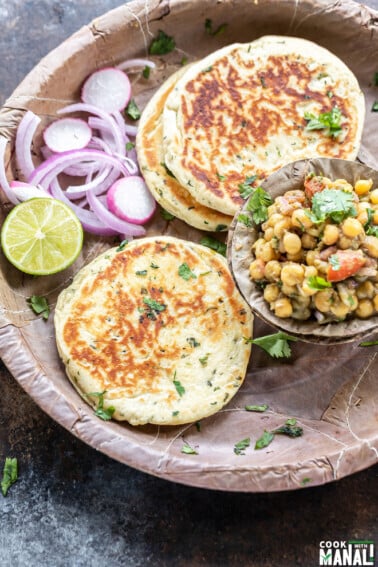
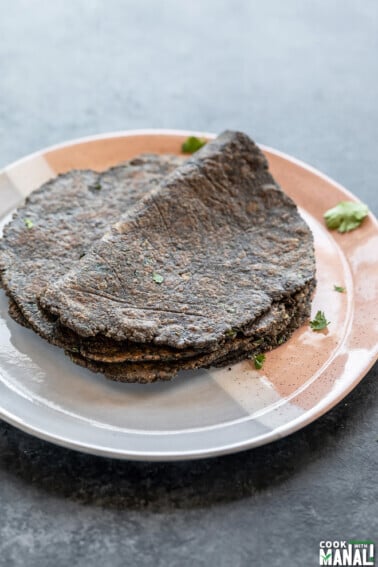









I’ve used this recipe several times now with great success. The chapatis puff up very nicely. Thanks for this delicious and straightforward recipe, Manali!
Thanks Lydia, glad it works every time!
Thanks for a great and easy recipe. I made a half batch of these today to accompany my homemade pumpkin curry soup. I just used half of the ingredients and added a couple of tablespoons of sourdough discard. They came out fantastic. I’m getting ready to make a whole batch now and freeze them!
thanks Debra for the feedback! Glad it worked with sourdough discard!
Thanks Manal for such a good how-to! After a few tries, I successfully made some perfect, puffing, soft roti .. a perfect paring with some paneer makhani. Homing in on the right softness of the dough and the cooking temp all came together for a great result. No hard-tack crackers here any more.
awesome! so glad to hear
I love the detail you gave, your passion and enthusiasm came through, and I can’t wait to try and try and learn just like you did. Thanks! I have also started following you on FB
Thanks Terry!
We love a straightforward and minimal ingredient recipe in our house and Minah you have made just that! The instructions were very clear and easy to follow; with your help my 10 year old daughter was able to make these rotis perfectly her first try! We cooked the batch at once on our blackstone flat top, all rotis puffed and turned deliciously speckled and crispy on the outside, with separation on the inside – perfect for scooping chicken handi and rice to shovel into our mouths. Happy campers!
so glad to hear that Alyssa! Thanks for trying!
Clear instructions made it easy to make. I was successful first time, thank you.
In Grenada recently, I had a curried chicken roti where the chicken and vegetables with sauce were inside the roti. It was wonderful. How is that made?
hmm it seems like a Caribbean version of roti. In India, our rotis are plain and this is an Indian roti recipe. When we stuff with vegetables, we call it a paratha.
Wonderful, clear instructions. Thank you!
They came so good and so soft. My boy loves them.
Dear Manali, I have tried to cook chapati/roti several times but they have always been too hard. Tonight I followed your recipe to the letter. I finished them over the flame and they puffed up perfectly, soft and easy to wrap around the food. Thank you for explaining the recipe and making it so easy to follow. Heather
so glad! 🙂
I’ve been trying to make oil free rotis for a while, but the dough was always very sticky – not so with your recipe – the details about adding water slowly etc really helped.
glad to hear Swati!
Thanks so much for an easy to follow recipe. The results were beyond my expectations and very tasty. I did add a little salt to the dough the second time I made these.
thanks for the feedback Wayne!
This is an excellent, easy to follow recipe.
I made the most perfect chapattis after years of them being just not quite right.
It was annoyingly easy with this recipe of just flour and water. Can’t recommend enough. Thank you.
Thank you. This is an excellent, easy to follow recipe.
I made the most perfect chapattis after years of them being just not quite right.
It was annoyingly easy with this recipe of just flour and water. Can’t recommend enough.
thanks for trying! 🙂 Glad it worked
Made my rotis and they came out perfect! Puffing and all. Thank you for the recipe. Now checking out what we can have with them. Minah from Zimbabwe.
glad to know Minah!
It was a great and fast recipe. Thank you will make again
Thank you for sharing.
Thank you for this post. Making roti is harder than it looks – technique is important at every step. I am getting better at it but I don’t think I am kneading to dough properly (my mother’s rotis are always softer than mine). Is it possible to over-knead dough? Does that make the rotis tough? My dough ends up being too wet or too dry – can’t seem to get it right. Any other tips? Can you make a video of the kneading?
Hi Ann, I am going to put a video and post on how I knead using my stand mixer so please look out for that. I shared a reel on Instagram for this , so you can check that out.
Thanks I will look for that. Can you also post a video on how to knead by hand? I have tried kneading with the mixer but it never turns out right.
I will try to post a video
Just tried your roti recipe step by step – would recommend it. I think I can almost make rotis now.
Many thanks
I was watching street food and she made a Roti and put I think banana chopped up with a scrambled raw egg then put on one side to cook then make it into a square and cook the other side. Then she put I think evaporated milk on just a drizzle it looked delicious 😋 please could you say if I am wrong or right as would love to make it. Thank you so very very much. Xxx
Thanks for the recipe. I’m new to cooking roti and it was a nice easy one to follow. We combined it with our coconut sausage casserole and rice. Next time I plan on adding curry powder and garlic to the bread. Thanks again, Paul
Hi Manali,
i am cooking for a party of 4 but want to make the Roti dough ahead of time, can i do this and keep in the fridge till ready to cook.
thanks
yes absolutely. I will just bring it to room temperature before, so take it out of the fridge for 30 minutes before you start making rotis.
Great simple recipe. I made half quantity with std wholemeal flour and 1tsp oil. Needed about 10% more water to get a nice smooth dough. Kneaded by hand for 7 mins for the dough to become really nice and soft. Rested for 30 mins. Came out beautifully! Super nice texture and nice and puffy. Interested to try with traditional atta flour
Hi so I think then I didn’t knead enough. Cause my roti were too stiff.
Keep trying
I made some beef nihari last night and wanted to get some roti to go with them. I followed the recipe and they turned out great! Only difference was I didn’t use any bench flour for rolling them out — my roti weren’t sticky at all. They came out puffy, beautiful freckled, and soft! I used the Sujata brand of chakki atta. Wonderful, nutty kind of taste to them. I will be making many more, these are delicious!
I made roti today for the second time following your recipe – and they were delicious! Some of them even fully puffed. :). I used 1 cup whole wheat flour + 1 cup white whole wheat flour + a little oil, and that worked well. I also used a tortilla press to shape the roti instead of rolling them. Thank you for wonderful directions!
yay! 🙂
thanks for the idea of a tortilla press. Pure genius!!!!!!! Thank you so much Laura!
Regards from Toulouse, France
Best instructions yet and I succeeded after 5th roti! Thank you so much, you made me feel proud! And they are yummy. I will always use this recipe from now on ☺️🤗
yay! glad to know!
Thanks Manali I make a good Roti but a little different with 5 rose white flour
But I am going to try your way with whole weat flour
Thank you for sharing
God bless you
I made these with some butter chicken I bought take out…they came together quite quickly…I simply combined the oil with water and added to regular Robin Hood whole wheat flour. I just did an easy one minute knead with the dough ball rolling method – nothing too aggressive – I didn’t want to have to rest the dough. Sure enough this method worked well – my rotis came out puffy and chewy with the gee applied(I just used melted Becel margarine). I’ve had roti at made by my indian bff’s mom a million times and these were pretty on par with what she always makes. Couldn’t be happier!
These look awesome. Having spent time in India and eaten many rotis over the years, I’m excited to try this recipe. Do I need a tawa, or would a regular pan work, i.e. nonstick flat griddle or heavy-bottomed cast iron?
cast iron will also work
I just used a regular Tefal pan on electric hob. Worked perfectly
We have roti all the time with family
what brand of atta do you use?
sujata gold is my favorite
This recipe is fantastic! Thank you so much for teaching me how to make roti! I had to play a bit with the heat on my electric cooktop and with the pan I was using. Half of my roti puffed up perfectly and few in the middle got too tough because the heat was either too high or too low but I adjusted and my last few roti were also perfect.
My first time roti weren’t perfect but they were tasty and I was so proud to have made them myself to go with my dhal – thank you for the great instructions!
Wow! This was so easy and delicious! Thank you so much for the detailed instructions and pointers. You helped me get good results on my first try!
Dear Manali
I often use your awesome recipes to cook vegetarian Indian food.
I want to thank you for the fantastic recipes you share on line the way you explain them to us , including so many useful tips!
My chapatis were great !!
All the bests and thanks so much again for the positive impact you had on my vegetarian diet!
Pietro
Thank you so much Pierto for the kind words. So glad to know that you enjoy the recipes that I share, I really appreciate the support! 🙂
I am single and without alot of freezer space for freezing them flat AFTER frying. Can I freeze the dough after it is rolled into balls to pull one out at a time to use? If so, how long do I need to let it rest before rolling the previously frozen dough out? Thank-you.
Best would be to half cook them and then freeze. Stack between parchment paper and then in a ziplock bag. I have never tried freezing dough balls, but if you do let me know hiw it turns out! I would thaw in refrigerator overnight.
I followed this recipe to a T and got great rotis! They puffed up and all, soft and tasty, amazing 😀 and it wasn’t a given because my induction stovetop is really powerful and it’s always a pain to get the right temperature (it goes from not hot enough to too hot in about 5s lol), thank you for the recipe!
awesome!
I also have induction. Where do you set it?
Can I just use ordinary wholemeal spelt flour to make the roti? I have made the fava and potato curry with veggies from the garden.
Sandy
you can try, traditionally we never use spelt flour to make roti so I have never used it.
Do you need a rolling board to make roti?
in India we do use a board (called as chakla) but you can make rotis on any flat surface.
This was the best recipe ever. I have tried to make roti before unsuccessfully, but the detailed instructions were very helpful and in the end, I made it this time successfully. Thank you so much for the clear and detailed instructions and for all you shared with others about this part of your culture! I have also tried your Palak paneer, which is the best recipe ever for that dish. I would love to see the video for the roti, though. Looking forward to that!
Thanks Ana, I will try and make a video for it soon!
I really like the detail you put in the recipe I don’t have to second-guess a thing.
glad it’s helpful Walter!
I’ve been using your recipes for years, and they never fail! This recipe made delicious rotis! And they all puffed beautifully. Thanks Manali!
Glad to know Viswa! 🙂
This recipe turned out so good, although I think mine didn’t puff up quite enough. I really appreciated the level of detail and I’ll definitely try again.
This the longest recipe I have ever read, I just want to make plain bread but I found myself reading a design project.
I’m in hurry and I have no time to read this long long article
You can always press “jump to recipe” button at the top if you are in a hurry. The long tips that I have written have been appreciate by many as it has helped them make good rotis.
People are so lazy. This is the best and easiest recipe. I hate long recipes and this was perfect!
glad it was helpful Devin! 🙂
Don’t be so rude. She wrote everything out to be the best help. Because she has the experience.
I haven’t tried the recipe yet but I really want to learn recipes from India. Is it imperative that I use whole wheat flour over white flour? Thanks for the recipe, I am excited to try it!
for roti, yes you have to use whole wheat flour (atta). Rotis are not made with white flour.
Awesome! Mine are always breaking up. I think you have told me why. Looking forward to trying yours. The detail is much appreciated.
This looks good!
Do you have a video please ?
I will try to add one Asha!
It all came out perfect, although I tweaked your recipes both the Roti and the Instant Pot Eggplant Carrot Curry. Used Chicken strips, Carrots and Green beans and had to substitute a lot cause I didn’t have some spices and herbs…. We had Instant Chicken Carrot Green beans Curry and Roti for Dinner, my family couldn’t stop licking their dishes and even had two servings each… Thank you Manali… Yet to try out your other dishes… Your detailed steps and tips make cooking so easy and simple…
thank you for trying! so glad you loved the recipes! 🙂
Hello, what brand of atta and ghee do you use?
Sujata gold atta and ghee homemade or Amul
Dear Manali
Is there a video?
If, not:—————————-
Please, please please make a video with a cherry on top!
{1 min video}
Thank you for the most recipe delicious recipe I read out aloud.
I will come to India and make it 4 u as a gift!
Amen,
noted Tim, I will try to upload a video on this page soon!
I have not acquired a Tawa yet. Is it necessary to have the slight curve? My Lodge cast iron 12” frypan makes decent ones. I still improving, will a true tawa help?
Demnavad
it’s okay, you don’t need a tava. Any pan will work 🙂
this is good guide with all the tips I cannot find elsewhere. YouTube videos skip too many finer details any my roti ends up different
I grind my own wheat berries. Will that be the correct type of whole wheat? They can be set fine, coarse or somewhere in between.
fine
What is the difference between atta flour and while wheat flour?
it’s in the texture and way wheat is processed